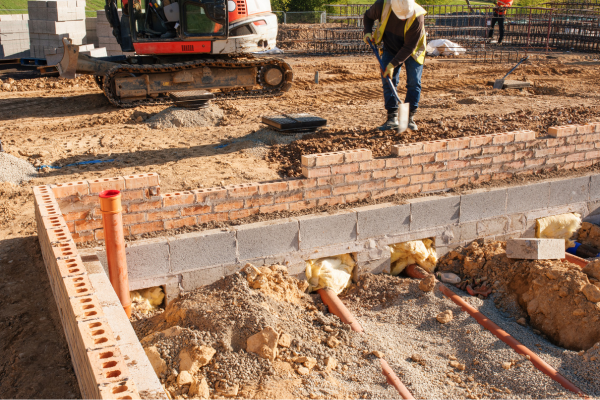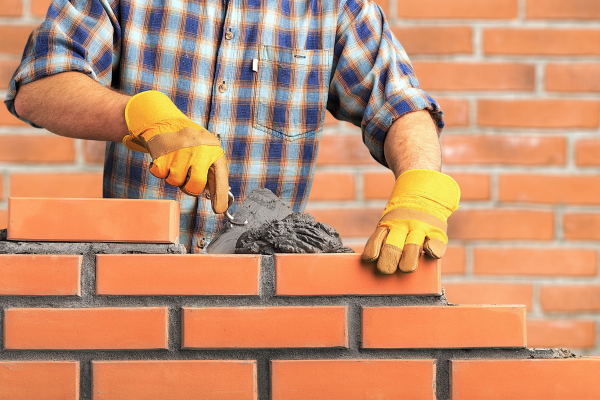10 Tips for the Bricklaying NVQ
The Level 2 Bricklaying NVQ, upon completion, is a testament to your skills, knowledge, and overall competence in the trade of bricklaying. If you’re already working as a bricklayer but you don’t have any qualifications, the NVQ is a way to formalise your experience and, ideally, make the next big step in your career.
But NVQs (National Vocational Qualifications) are quite involved, and they’re very different from more traditional, academic qualifications. So, in today’s blog, we’ll be breaking down 10 tips to help you complete your NVQ with minimal hassle.

Tip 1: Understand the Assessment Criteria Thoroughly
This is arguably the most crucial step. Before you start gathering evidence for the NVQ, you need to have a full understanding of what your assessor is looking for in each unit. The qualification is broken down into various units, each with specific learning outcomes and assessment criteria. These criteria detail the precise skills, knowledge, and behaviours that you need to demonstrate.
Tip 2: Document Everything for Your Bricklaying NVQ
The qualification, like all NVQs, is competency-based. This means it assesses what you can do in a real working environment. The only way to prove this is through comprehensive documentation, so think of yourself as a meticulous record-keeper from day one.
Actionable advice:
- Site Diaries: Maintain a daily or weekly diary detailing the tasks you’ve performed, the materials used, challenges faced, and how you overcame them. This will help provide context for your photographic and video evidence.
- Photographic Evidence: Take high-quality photos of your work at different stages. Include photos of various bonds, corner details, archways, and any complex features you’re responsible for.
- Video Evidence: Short video clips can be particularly helpful. Show yourself performing specific techniques, such as mixing mortar, setting out, using spirit levels, or cutting bricks accurately. You can also video discussions with colleagues or supervisors about project specifics, highlighting your communication skills.
- Witness Testimonies: Get written statements from supervisors or experienced colleagues who can vouch for your skills, and your competence in specific tasks.
- Workplace Documents: Keep copies of relevant site documents you’ve contributed to or followed, such as risk assessments.
The more detailed and varied your evidence, the stronger your case for demonstrating competence for your qualification.
Tip 3: Regular Communication with Your Assessor
Your assessor is there to help guide you through the NVQ process. Think of them as a mentor; their goal isn’t to catch you out, but to help you succeed, and acquire your qualification. Establishing regular communication with them can be vital.
Tip 4: Embrace Different Techniques During the Bricklaying NVQ
An NVQ demonstrates versatility and competence across a wide range of bricklaying tasks. Don’t limit yourself to the familiar, or the easy. Actively seek out opportunities to expand your practical experience.

Tip 5: Seek Feedback
Feedback is the cornerstone of improvement. It provides an external perspective on your work, highlighting areas of strength, and identifying where you might need to refine your technique or understanding.
Tip 6: Showcase Your Problem-Solving Abilities Throughout the Bricklaying NVQ
A truly competent bricklayer isn’t just someone who can lay bricks; it’s someone who can anticipate, identify, and effectively resolve problems that arise on site. Your NVQ should demonstrate this.
Actionable advice:
- Document challenges: When you encounter an issue- e.g., an uneven foundation, an incorrect material delivery, a tricky cut, or unexpected weather conditions- document it.
- Detail your solution: Explain the steps you took to address the problem. Did you consult with a supervisor? Did you adapt your approach? Did you recalculate measurements?
- Show the outcome: Provide evidence (photos/videos) of the successful resolution of the problem.
- Reflect on the learning: In your written statements or discussions with your assessor, explain what you learned from the experience and how it will inform your future practice.
- Think critically: When faced with a problem, don’t just react. Take a moment to analyse the situation, consider potential solutions, and choose the most effective and safest approach. This critical thinking will be a key aspect of your NVQ.
Demonstrating your ability to troubleshoot and adapt proves you’re a capable and reliable professional.
Tip 7: Organise Your Online Portfolio
Most NVQ providers, including CST Training, use online platforms for evidence submission. A well organised digital portfolio is vital for ensuring your NVQ goes as smoothly as possible; the last thing you want is for your portfolio to get cluttered, which could slow down your progress.
Tip 8: Highlight Health and Safety Practices for Your Bricklaying NVQ
Health and safety isn’t just a separate unit in your NVQ; it’s an inherent part of every task you perform. Your assessor will be looking for continuous evidence of your commitment to safe working practices throughout all your documented activities.
Tip 9: Don’t Rush
Trying to rush your NVQ, for whatever reason, could lead to overlooked details, insufficient evidence, and potential errors, which can ultimately prolong the process.
Actionable advice:
- Set realistic deadlines: Work with your assessor to set achievable targets for completing units.
- Allow time for reflection: After completing a task, take time to reflect on your performance, consider what went well, and what could be improved. This self-assessment is valuable for your learning, and for your portfolio.
- Avoid burnout: Break down the NVQ into manageable chunks. Don’t try to cram too much into a short period, as this could lead to fatigue.
A steady, methodical approach will ensure a higher quality of work and a smoother completion of your NVQ.
Tip 10: Utilise Digital Tools for Your Bricklaying NVQ
In today’s construction environment, digital literacy is increasingly important, and it can significantly streamline your NVQ process. Embrace technology to your advantage. Specifically, get familiar with the specific online platform your NVQ provider uses. Learn how to upload, categorise, and annotate your evidence effectively.
Why Do People Take the Bricklaying NVQ?
People pursue the NVQ for a variety of compelling reasons:
- Formal Recognition: For many experienced bricklayers, the NVQ formally recognises skills they’ve developed over years on the job, providing a nationally recognised qualification.
- CSCS Card Eligibility: A primary driver is often the need for a CSCS (Construction Skills Certification Scheme) card. The Bricklaying NVQ at Level 2 or 3 is a common route to obtaining the blue or gold CSCS card, which is essential for access to most construction sites in the UK.
- Career Advancement: The NVQ demonstrates competence and commitment, making individuals more attractive to employers for higher-level roles, supervisory positions, or even self-employment.
- Professional Development: It encourages a structured approach to learning and validates a wide range of practical skills, from basic bricklaying to complex features and adherence to safety standards.
- Contractual Requirements: Many main contractors require all operatives on their sites to hold relevant NVQs, making it a necessity for work.
- Proof of Competence: For self-employed bricklayers, an NVQ offers tangible proof of their professional abilities to potential clients.
Benefits of Taking a Competency-Based Qualification
The NVQ differs significantly from traditional exams:
- Real-World Application: It assesses skills in your actual working environment, ensuring that what you learn is directly applicable to your job.
- Flexible Learning: You’re not tied to classroom schedules. You gather evidence as you work, fitting the assessment around your existing commitments.
- Focus on ‘Doing’: The emphasis is on demonstrating practical competence, not just theoretical knowledge.
- Personalised Assessment: Your assessor works with you individually, tailoring the process to your specific projects and opportunities.
- Valuable Portfolio: You build a tangible portfolio of your work, which can be used to showcase your skills to future employers.
Next Steps After Completing the Qualification
Once you’ve acquired your NVQ, you’re one step closer to applying for a CSCS Card, typically a Blue Skilled Worker Card (although this can vary depending on your level of experience). A CSCS Card can open a myriad of doors to roles across the construction industry. You may also want to consider specialising in a particular kind of brickwork, or even teach the trade to others. Further down the line, once you’ve racked up more experience, you can take the Level 3 NVQ in Bricklaying.
When Should I Take the Level 3 NVQ?
The Level 2 NVQ is typically for those who have a solid understanding of basic bricklaying and are working under supervision. The Level 3 NVQ, on the other hand, is for more experienced bricklayers who demonstrate advanced skills, can work autonomously, and often handle more complex projects or supervise others.
You should consider taking the Level 3 NVQ when:
- You have successfully completed your Level 2 NVQ.
- You have substantial experience (often several years) beyond the Level 2 scope.
- You are regularly undertaking complex bricklaying tasks without direct supervision.
- You are involved in planning, setting out, or leading smaller teams.
- You want to further differentiate yourself and open up more advanced career opportunities, particularly those requiring a Gold CSCS card.
Consult with your training provider or assessor to determine if your current experience and role align with the requirements of the Level 3.
Conclusion: 10 Tips for the Bricklaying NVQ
Embarking on your NVQ journey is a significant step in your professional development. By diligently following these 10 tips- from thoroughly understanding the assessment criteria and meticulously documenting your work for your NVQ, to proactively communicating with your assessor and embracing diverse bricklaying challenges – you’ll be setting yourself up for continued success.

If you still have any questions regarding the NVQ, then do not hesitate to get in touch.
Phone – 020 3488 4472





